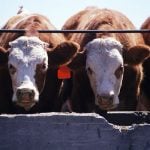By Glen Hallick, MarketsFarm
Glacier FarmMedia MarketsFarm – Intercontinental Exchange canola futures fell back on Friday, as the recent rally turns into rangebound trading.
An analyst said that without any fresh news canola has “no appetite to go higher.”
Today’s losses saw the January canola contract slip behind its 20-day moving average, but it remained above the 50-day average.
Added to that, weakness in Chicago soyoil, MATIF rapeseed and Malaysian palm oil put pressure on canola. Increases in Chicago soybeans and soymeal tried to temper the declines. Losses in crude oil weighed on vegetable oil values.
Read Also
ICE Canola Midday: ‘Non-descript trade’ weakens prices
By Glen Hallick Glacier FarmMedia | MarketsFarm – Intercontinental Exchange canola futures were pulling back mid-morning Friday, in what an…
There was some good news for canola, as the Canadian Grain Commission reported the oilseed’s exports for the week ended Nov. 16 improved more than 57 per cent at a marketing-year high of 284,600 tonnes. However, the year-to-date for 2025/26 of 1.83 million tonnes is slightly more than the year ago exports.
The Canadian dollar was a pinch lower on Friday afternoon with the loonie at 70.95 U.S. cents compared to Thursday’s close of 71.02.
There were 38,768 contracts traded on Friday, compared to 39,056 on Thursday. Spreading accounted for 24,562 contracts traded.
Prices are in Canadian dollars per metric tonne:
Price Change
Canola Jan 641.10 dn 9.10
Mar 653.70 dn 9.30
May 664.40 dn 8.60
Jul 670.70 dn 7.40
SOYBEAN futures at the Chicago Board of Trade turned around from earlier losses on Friday to close higher, but soyoil remained on the downside.
A Bloomberg report said the Trump administration is to announce its multi-billion dollar aid package for farmers affected by low commodity prices sometime in early December.
S&P Global projected planted U.S. soybean acres for 2026/27 at 84.5 million for a 4.2 per cent increase from those in 2025/26.
Soybean planting in Brazil is said to be 76 per cent complete as of Wednesday, five points behind the five-year average.
The Buenos Aires Grain Exchange placed soybean planting in Argentina at nearly 25 per cent finished, up about 12 points on the week, but 11 behind a year ago.
The Grain Industry Association of Western Australia upped its call on 2025/26 canola production in that state by about 11 per cent at 4.30 million tonnes. The five-year average is 2.80 million tonnes.
CORN futures were slightly lower on Friday, with little news to move further either way.
The BAGE estimated corn planting in Argentina about 37 per cent complete, up less than one point on the week. The crop rated 79 per cent good to excellent.
WHEAT futures were mixed on Friday, with gains in Kansas City and losses in Chicago and Minneapolis.
The U.S. weather outlook called for rain next week across the Southern Plains and snow for the Northern Plains. The National Oceanic and Atmospheric Administration forecast below normal temperatures and above normal precipitation for the Northern Plain over the coming three months, while the Southern Plains are to see the opposite conditions.
S&P Global placed planted U.S. wheat acres at 44 million, down 700,000 from 2025/26, matching yesterday’s estimate from Informa.
December options expire today with first notice day on Nov. 28.
France said 95 per cent of its soft wheat crop has been seeded and it rates 98 per cent good to excellent.
The GIWA increased its estimate on Western Australia’s wheat crop by a little more than three per cent at 13.10 million tonnes. The state’s five-year average is 11.20 million tonnes.









